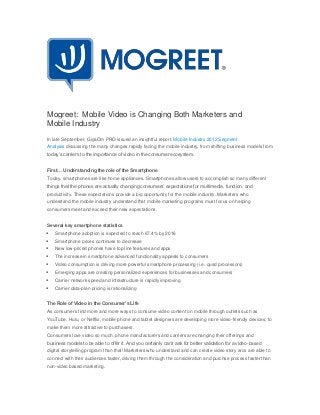
Mogreet: mobile video is changing both marketers and mobile industry
- 1. Mogreet: Mobile Video is Changing Both Marketers and Mobile Industry In late September, GigaOm PRO issued an insightful report, Mobile Industry 2012 Segment Analysis discussing the many changes rapidly facing the mobile industry, from shifting business models from today’s carriers to the importance of video in the consumer ecosystem. First… Understanding the role of the Smartphone Today, smartphones are like home appliances. Smartphones allow users to accomplish so many different things that the phones are actually changing consumers’ expectations for multimedia, function, and productivity. These expectations provide a big opportunity for the mobile industry. Marketers who understand the mobile industry understand that mobile marketing programs must focus on helping consumers meet and exceed their new expectations. Several key smartphone statistics Smartphone adoption is expected to reach 67.4% by 2016 Smartphone prices continues to decrease New low-priced phones have top line features and apps The increase in smartphone advanced functionality appeals to consumers Video consumption is driving more powerful smartphone processing (i.e. quad processors) Emerging apps are creating personalized experiences for businesses and consumers Carrier network speed and infrastructure is rapidly improving Carrier data-plan pricing is rationalizing The Role of Video in the Consumer’s Life As consumers find more and more ways to consume video content on mobile through outlets such as YouTube, Hulu, or Netflix, mobile phone and tablet designers are developing more video-friendly devices, to make them more attractive to purchasers. Consumers love video so much, phone manufacturers and carriers are changing their offerings and business models to be able to offer it. And you certainly can’t ask for better validation for a video-based digital storytelling program than that! Marketers who understand and can create video story arcs are able to connect with their audiences faster, driving them through the consideration and purchse process faster than non-video based marketing.
- 2. Why marketers should be using video to engage customers: Mobile video traffic was 52% of all mobile traffic in 2011 (Cisco, 2012) Mobile video messages have 300% more engagement than SMS text messages (Mogreet, 2011) 36M US consumers watch video on their mobile phones (Nielson, 2012) 4G data subscribers are 33% more likely to watch a video on their smartphone (Business Insider, SAI, 2012) Visitors who view product videos are 85% more likely to buy than visitors who do not (Internet Retailer, 2010) 61% of consumers visited a store after watching a product video (Google, 2012) A minute of video is worth 1.8 million words (Omnivideo, 2009) Humans process visuals 60,000 times faster than text (Cisco, 2010) 67% of customers value the quality of a product image more than the textual description or review (MDV Blog 2012) 43% of mobile phone users have swapped their camera for a mobile device (Oracle) Mobile video can be monetized with sponsored pre- or post-roll video clips (Mogreet, 2012) Mobile video moves customers through the purchase funnel faster, while providing a fully branded experience and the basis of interactivity. The simple consumption of a video doesn’t only make explanations easier, consumers see it as an extension of television and therefore it inherently seems like social activity. People watch and interact with TV programs and now they’re interacting with online and mobile video too. So how do you share mobile video? The big question left is how do today’s marketers share mobile video with their customers. Of course there is mobile web-streaming viewing. But the downside is that streaming quickly eats up the customers’ data usage (a growing issue as today’s carriers do away with unlimited data plans). There are mobile apps, but with 600,000 apps on the market, users finding and using certain apps can be difficult. The best way to distribute mobile video is the old fashioned way – simply text it. With 74% of all U.S. consumers having received or sent a multimedia (MMS) text message, the text-messaging channel is familiar and easy for the consumer to understand and use. Why use MMS to send mobile video? MMS is ubiquitous – smartphone or basic phones can receive it 95% of U.S. mobile phones receive SMS/MMS messages (Nielsen, 2012) Text messaging is t
